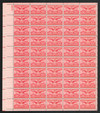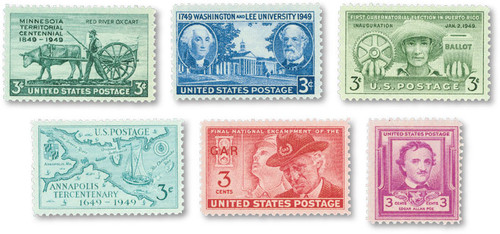
# C40 - 1949 6c Airmail Alexandria, VA
1949 6¢ Founding of Alexandria, VA
Quantity: 75,085,000
Perforations: 11 X 10 ½
Founding of Alexandria, Virginia
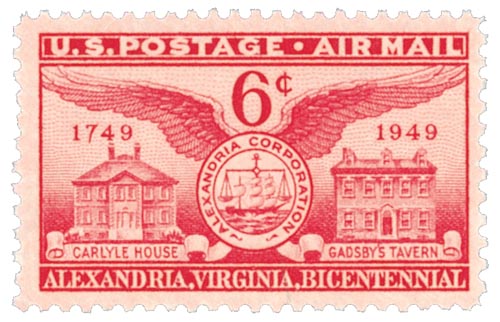
On May 2, 1749, the House of Burgesses approved the creation of a town that would become Alexandria, Virginia. George Washington helped plan the town’s street systems and Alexandria was part of the US capital for several years.
In October 1669, Robert Howsing received a patent for 6,000 acres in the area to bring 120 people to the Colony of Virginia. After the passage of the Tobacco Inspection Law of 1730, a warehouse was established on the upper Potomac River along Hunting Creek. The law required that all the tobacco grown in the colony be inspected at a local warehouse before sale.

In the 1740s, Fairfax County residents formed the Ohio Company of Virginia with the goal of opening trade with areas further inland. They wanted to establish their post at the head of the Potomac River, and the Hunting Creek tobacco warehouse would provide the perfect location for a trading port.
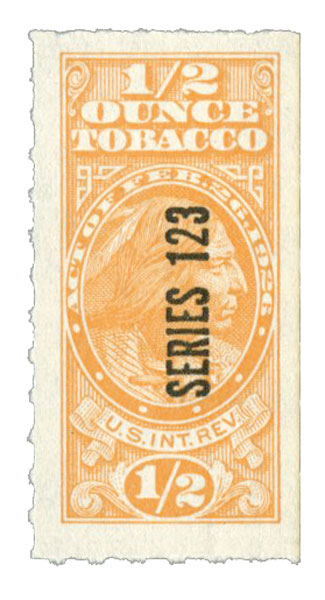
In November 1748, the residents of Fairfax County submitted a petition to the House of Burgesses “praying that a town may be established at Hunting Creek Warehouse on the Potowmack River.” Lawrence Washington introduced the petition and represented Fairfax County. His younger brother George Washington, a novice surveyor, provided a sketch, showing the benefits of establishing a town at that site. The land they wanted for their town was owned by Philip Alexander II, who initially opposed the idea. When the petitioners offered the name the town Alexandria after his family, however, he supported their proposal.
On May 2, 1749, the House of Burgesses approved their petition and ordered “Mr. Washington do go up with a Message to the Council and acquaint them that this House have agreed to the Amendments titled An Act for Erecting a Town at Hunting Creek Warehouse, in the County of Fairfax.” In the coming months, a town surveyor laid out streets. For a time, the town was called Belhaven, likely after Scottish Patriot John Hamilton, 2nd Lord Belhaven and Stenton. The name was never approved by the legislature and the town of Alexandria was officially incorporated in 1779.
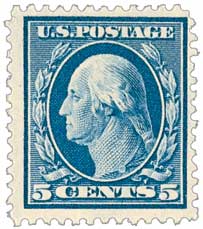
Alexandria would see several historic events over the years. In 1755, General Edward Braddock organized his expedition against Fort Duquesne at the Carlyle House. And at Gadsby’s Tavern, George Washington recruited his first command in 1754 and his last military review in 1799.
In 1791, Washington included Alexandria in his plans for the District of Columbia. However, over time the citizens of Alexandria wished to be separated from the nation’s capital. They didn’t have representation or the right to vote at any level of government. On July 9, 1846, Alexandria was retroceded to Virginia.
Some of the first fatalities for both sides of the Civil War were inflicted at Alexandria. On May 24, 1861, Union Colonel Elmer E. Ellsworth led a small detachment to the Marshall House Inn. Atop the inn was a large Confederate flag that could be seen from the White House. Ellsworth removed the flag but was killed by the hotel’s owner as he came down the stairs. The hotel owner was then killed by one of Ellsworth’s men. Both men were considered martyrs to their respective causes. Alexandria was under military occupation for the remainder of the war.
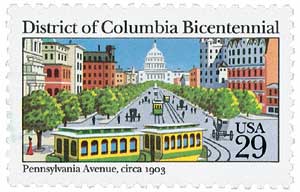
By the 1900s, Alexandria’s main industries were glass, fertilizer, beer, and leather. It was home to one of the largest rail facilities in the country as well as a torpedo station during both World Wars. Many of the city’s historic buildings remain as museums and historic sites. Several national associations and corporations are headquartered there. It’s also home to many federal employees. Over the years, several magazines have named the town one of the prettiest, happiest, and best cities in the South.
1949 6¢ Founding of Alexandria, VA
Quantity: 75,085,000
Perforations: 11 X 10 ½
Founding of Alexandria, Virginia

On May 2, 1749, the House of Burgesses approved the creation of a town that would become Alexandria, Virginia. George Washington helped plan the town’s street systems and Alexandria was part of the US capital for several years.
In October 1669, Robert Howsing received a patent for 6,000 acres in the area to bring 120 people to the Colony of Virginia. After the passage of the Tobacco Inspection Law of 1730, a warehouse was established on the upper Potomac River along Hunting Creek. The law required that all the tobacco grown in the colony be inspected at a local warehouse before sale.

In the 1740s, Fairfax County residents formed the Ohio Company of Virginia with the goal of opening trade with areas further inland. They wanted to establish their post at the head of the Potomac River, and the Hunting Creek tobacco warehouse would provide the perfect location for a trading port.

In November 1748, the residents of Fairfax County submitted a petition to the House of Burgesses “praying that a town may be established at Hunting Creek Warehouse on the Potowmack River.” Lawrence Washington introduced the petition and represented Fairfax County. His younger brother George Washington, a novice surveyor, provided a sketch, showing the benefits of establishing a town at that site. The land they wanted for their town was owned by Philip Alexander II, who initially opposed the idea. When the petitioners offered the name the town Alexandria after his family, however, he supported their proposal.
On May 2, 1749, the House of Burgesses approved their petition and ordered “Mr. Washington do go up with a Message to the Council and acquaint them that this House have agreed to the Amendments titled An Act for Erecting a Town at Hunting Creek Warehouse, in the County of Fairfax.” In the coming months, a town surveyor laid out streets. For a time, the town was called Belhaven, likely after Scottish Patriot John Hamilton, 2nd Lord Belhaven and Stenton. The name was never approved by the legislature and the town of Alexandria was officially incorporated in 1779.

Alexandria would see several historic events over the years. In 1755, General Edward Braddock organized his expedition against Fort Duquesne at the Carlyle House. And at Gadsby’s Tavern, George Washington recruited his first command in 1754 and his last military review in 1799.
In 1791, Washington included Alexandria in his plans for the District of Columbia. However, over time the citizens of Alexandria wished to be separated from the nation’s capital. They didn’t have representation or the right to vote at any level of government. On July 9, 1846, Alexandria was retroceded to Virginia.
Some of the first fatalities for both sides of the Civil War were inflicted at Alexandria. On May 24, 1861, Union Colonel Elmer E. Ellsworth led a small detachment to the Marshall House Inn. Atop the inn was a large Confederate flag that could be seen from the White House. Ellsworth removed the flag but was killed by the hotel’s owner as he came down the stairs. The hotel owner was then killed by one of Ellsworth’s men. Both men were considered martyrs to their respective causes. Alexandria was under military occupation for the remainder of the war.

By the 1900s, Alexandria’s main industries were glass, fertilizer, beer, and leather. It was home to one of the largest rail facilities in the country as well as a torpedo station during both World Wars. Many of the city’s historic buildings remain as museums and historic sites. Several national associations and corporations are headquartered there. It’s also home to many federal employees. Over the years, several magazines have named the town one of the prettiest, happiest, and best cities in the South.






